
|
Sale 80
June Pre Long Beach Sale
| Lot |
Photo |
Description |
Realized |
Lot 1620 |
 |
1836 Pattern Dollar. Silver, Plain Edge. Judd-60. Pollock-65 Rarity 1. PCGS graded Proof 61. Nice even toning on both sides. A splendid specimen, as graded, of this, one of the most important of all American silver coins of any denomination. Both obverse and reverse are toned light smoky gray, nicely blended, yielding a treat to the eye. The reverse die is in normal coin alignment, 180° opposite the obverse die, with the eagle flying "onward and upward," a phrase from early Mint correspondence.
Just 1,000 of these pieces were minted in December, 1836, all with Proof finish. Some of them were presented here and there, including two to President Andrew Jackson, others to Treasury officials, and a few to numismatic cabinets. Afterwards, many hundreds were simply put into circulation for face value. This is the first (but not only) instance in which a coin made from polished dies, deliberately with Proof finish, proved to be a circulating issue. For many years the variety was considered to be a pattern, designated as J-60, but some consider this to be misdirected. Current thinking is the pieces were regular issue, not patterns or experimental in any way.
The genesis of the Gobrecht dollar began in 1835 when Christian Gobrecht was hired at the Philadelphia Mint, to help Chief Engraver William Kneass, who in August had suffered a debilitating stroke. Gobrecht, whose credentials far exceeded those of Kneass, and who was one of the best known engravers in the United States (having done extensive work on illustrated books, for medals including for the mint, and on bank notes), did not want to be called assistant engraver, and was hired as a second engraver, in his mind this meaning "another engraver," not someone subsidiary in rank. In any event, from that point onward Gobrecht created nearly all of the new die work turned out.
In its final form the Gobrecht silver dollar appeared as here, with a Liberty Seated figure in cameo on the obverse, name inconspicuously on the base, and with the eagle flying onward and upward on the reverse, amid a galaxy of 26 stars, 13 large and 13 small. At the time there were 35 states in the Union, but it was not long until Michigan became the 26th (in 1837).
In early 1837 additional Gobrecht dollars from these dies were struck, of a different standard under the authority of January 18, 1837, and differentiated from the originals by having the dies aligned differently. Still later, restrikes were made at the mint, probably through the early 1870s. Pop 22; 69 finer, 33 in 62, 1 in 62+, 22 in 63, 13 in 64 (PCGS # 11225) .
Estimated Value $20,000 - 21,000.
View details and enlarged photos
Check results on similar lots
| Realized
$22,913 |
Lot 1621 |
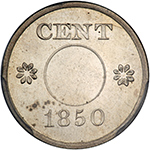 |
1850 Pattern Cent. Nickel, Plain Edge Judd-124g High Rarity 7. PCGS graded Proof 65 PQ. CAC Approved. A nice mostly untoned gem. The Patterns for the one-cent piece requested in 1849 by the Committee of Ways and Means first appeared in 1850. The original pieces were made from billon, an alloy composed of 10% silver and 90% copper, are perforated and weigh 25 grs. The pieces made from cracked dies and all the unperforated pieces are restrikes. Since nickel was not in use at the Mint in 1850, the copper-nickel pieces are also restrikes made at a later date.
Small cent annular (ring-form) Pattern, simply laid out with *CENT*1850 on the obverse. Unperforated. The reverse is plain except for denticles and an upset rim. Struck in nickel with a plain edge. Formerly an Appendix A Pattern in the 1st through 7th editions of Judd. Fewer than half a dozen pieces are believed known. This piece shows the die crack through the top of CENT as seen on at least one other example. The surfaces are bright and virtually brilliant with just the slightest hint of golden toning around the margins. Struck on a lightly striated planchet. A couple of shallow planchet flaws on the reverse serve as an aid for future pedigree identification. Pop 2; none finer at PCGS (PCGS # 62312) .
Estimated Value $7,000 - 7,500.
View details and enlarged photos
Check results on similar lots
| Realized
$7,344 |
Lot 1622 |
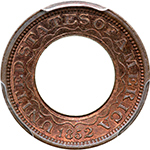 |
1852 Pattern Gold Dollar. Copper, Plain Edge. Judd-147. Pollock-175 Low Rarity 7. PCGS graded Proof 66 Red & Brown PQ. CAC Approved. A lovely example. This is the plain edge, copper variety of the proposed Ring Dollar or "Annular" Dollar coin, a proposal to bring smaller denomination gold coins into circulation like the half dollar and one-dollar but enlarged in diameter for ease of use. Problems striking these were numerous since the equipment had to deal with the central perforation. Some first attempts had irregular openings, which would never do to a Mint establishment that prided itself on quality workmanship. A rare, high grade example that is tied for the finest at PCGS. Pop 3; none finer at PCGS (PCGS # 11611) .
Estimated Value $9,000 - 10,000.
View details and enlarged photos
Check results on similar lots
| Realized
$10,281 |
Lot 1623 |
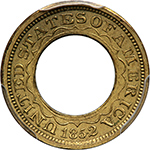 |
1852 Pattern Gold Dollar. Brass, Plain Edge. Judd-148b Rarity 8. PCGS graded Proof 63 PQ. CAC Approved. Tied for the finest at PCGS. A rare Pattern annular Dollar struck from cracked dies in brass. During this period the silver coins were disappearing from circulation due to the fact that they contained more bullion than their face value. Hence there was a demand for gold coins of the dollar and half-dollar denomination. Walter Breen found in the Archives a letter from the Director of the Mint, George N. Eckert, to Senator R. M. T. Hunter dated January 27, 1852, which shows that the half-dollar and larger ring-gold dollar were the first pieces made.
Fortunately the stopgap Act of 1853 reduced the silver content of the coins, making them worth less than face as bullion. This increased the circulation of silver coins and relieved the need for the small gold pieces. Although the Act improved things, it caused greater problems down the line. Pop 2; none finer at PCGS (PCGS # 11618) .
Estimated Value $15,000 - 16,000.
View details and enlarged photos
Check results on similar lots
| Realized
$17,038 |
Lot 1624 |
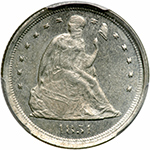 |
1854 Pattern Cent. German Silver, Reeded Edge. Judd-157. Pollock-185 High Rarity 7. PCGS graded Proof 64. CAC Approved. Experimental. A scarce pattern, the obverse is derived from a Seated dollar obverse die, but crudely reduced by a circular lathe to the diameter of a contemporary half cent. The 4 in the date resembles a 1 because of the blurry reduction. On the reverse, 1 CENT is encircled by an oak and acorn wreath. Struck with a reeded edge in a German silver alloy with the combination stated above. Pop 2; 2 finer, 1 in 64+, 1 in 65 (PCGS # 11650) .
Estimated Value $5,000 - 5,500.
Ex: Samuel Berngard Collection.
View details and enlarged photos
Check results on similar lots
| Unsold |
Lot 1625 |
 |
1859 Pattern Half Dollar. Silver, Reeded Edge. Judd-235. Pollock-282 Rarity 5. PCGS graded Proof 65. CAC Approved. Nice blue toning and a bold Gem Proof. Anthony C. Paquet's obverse design features a left-facing Liberty, seated, supporting a fasces with her right hand and a shield with her left. Thirteen small stars surround the periphery with the date, 1859, in exergue. Arrows and olive branches lie at the base of the shield. Reverse Also by Paquet. A slightly disproportionate eagle, with wings spread, holds three slender arrows in its left claw and an olive sprig with its right talon. The perfect scroll held in the eagle's beak reads E PLURIBUS UNUM with UNITED STATES OF AMERICA occupying the upper periphery and HALF DOLLAR the lower. The vertical lines in the shield are in groups of four each, as opposed to three lines as found on the similar "broken ribbon" version of this pattern. Struck in silver with a reeded edge. A sharply impressed and wonderfully preserved example. Pop 5; none finer at PCGS (PCGS # 11960) .
Note: Anthony C. Paquet designed several Pattern pieces in the mid-nineteenth century, including a variation on the 1858 Gold Dollar. He was noted for his tall ornate lettering, which is easily spotted by those familiar with it. His most famous design, one which actually made it into limited production, was the 1861 Liberty Head Double Eagle with Paquet reverse. The Paquet-designed San Francisco mint version is available periodically.
Estimated Value $4,500 - 5,000.
View details and enlarged photos
Check results on similar lots
| Unsold |
Lot 1626 |
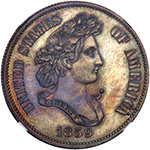 |
1859 Pattern Half Dollar. Copper, Reeded Edge. Judd-242. Pollock-298 Rarity 5. NGC graded Proof 66 BN. Nice shades of brown toning. Pop 1; none finer at NGC (PCGS # 11980) .
Estimated Value $4,500 - 5,000.
View details and enlarged photos
Check results on similar lots
| Realized
$5,170 |
Lot 1627 |
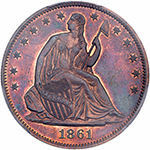 |
1861 Pattern Half Dollar. Copper, Reeded Edge. Judd-280. Pollock-331 Low Rarity 7. PCGS graded Proof 65 Red & Brown PQ. CAC Approved. Lovely red and blue toning. A With Motto half dollar that is similar to the as-struck Seated half, except the motto GOD OUR TRUST is set directly into the upper reverse field. Struck in copper with a reeded edge. Obviously struck at some time later than 1861 as the suggestion for a motto on coinage was not made until 1863. Significant portions of original mint red survives, especially around the devices. A well-balanced Gem with nicely reflective fields. Pop 1; none finer at PCGS (PCGS # 12109) .
Estimated Value $8,000 - 8,500.
View details and enlarged photos
Check results on similar lots
| Realized
$9,106 |
Lot 1628 |
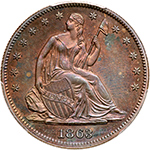 |
1863 Pattern Half Dollar. Copper, Reeded Edge. Judd-341. Pollock-413 Rarity 5. PCGS graded Proof 64 Red & Brown. A small obverse spot. Nicely toned. GOD OUR TRUST in field above eagle. This year is notable for the appearance of a set of Patterns for the silver dollar, half and quarter, combining the regular obverse dies and the reverses adopted in 1866 with the motto "IN GOD WE TRUST" on a scroll above the eagle. (The set of Pattern half dollars and eagles with the motto 'GOD OUR TRUST' issued in 1861 and 1862 were struck again, redated 1863, this being a half dollar from the group.) Pop 3; none finer at PCGS (PCGS # 70) .
Estimated Value $3,200 - 3,400.
View details and enlarged photos
Check results on similar lots
| Realized
$3,525 |
Lot 1629 |
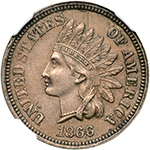 |
1866 Pattern Cent. Copper-Nickel, Plain Edge. Judd-456. Pollock-530 Low Rarity 7. NGC graded Proof 62. Even brown toning. Regular dies struck on an unusual copper-nickel, plain edge planchet. A copper-nickel Pattern for the Two-cent denomination was also minted this year. Dullish pink-copper color with some obverse handling marks noted around OF, below TES and elsewhere. Rarely offered: Pop 1; 1 finer in 63.
Estimated Value $1,800 - 1,900.
View details and enlarged photos
| Realized
$1,998 |
Lot 1630 |
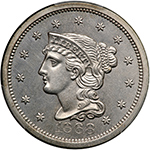 |
1868 Pattern Ten Cents. Nickel, Plain Edge. Judd-647. Pollock-720 Low Rarity 6. PCGS graded Proof 66. CAC Approved. A nice untoned pattern. Gorgeous Gem Proof. Early in the year, a Congressman Kelley introduced a bill providing for the coinage of one, three, five and ten cent pieces from an alloy of nickel and copper, to be legal tender to the amount of one dollar in replacing the minor coins and fractional currency then in circulation. This is the Pattern Ten Cent design the Mint created to show how the proposed coin might look. It carries the old large cent�s Braided Hair head of Liberty from the device punch held over from the 1850s as used on the large cent of 1857. On the reverse, TEN CENTS within a laurel wreath. Struck on a 10 gram weight copper and nickel alloy planchet. According to Judd, "because of delay in preparing the dies for the proposed ten cent piece, the first test pieces were struck in March, 1868 on the screw press, using dies made from the hubs of the large cent, which were still available." The pieces in nickel and copper alloy weigh 10 grams as specified in the proposed bill for this coinage series. Pop 4; 2 finer in 67 (PCGS # 60865) .
Estimated Value $7,500 - 8,000.
View details and enlarged photos
Check results on similar lots
| Realized
$9,106 |
Lot 1631 |
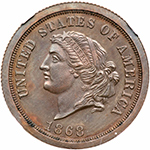 |
1868 Pattern Half Eagle. Copper, Reeded Edge. Judd-656. Pollock-729 Low Rarity 7. NGC graded Proof 66 BN. Nice even brown toning. Pop 3; 1 finer in 66+ Star .
Estimated Value $16,000 - 18,000.
View details and enlarged photos
| Realized
$18,213 |
Lot 1632 |
 |
1869 Pattern Dime. Copper, Plain Edge. Judd-711. Pollock-790 High Rarity 7. PCGS graded Proof 64 Red & Brown PQ. CAC Approved. Traces of mint red. STANDARD SILVER type, head of Liberty wearing a coronet with one star; IN GOD WE TRUST on a scroll below. The normal STANDARD SILVER dime reverse that is used on these 1869-dated Pattern Dimes and some subsequent year issues as well. Luminous copper-gold surfaces with dusky purple brown areas. Desirable with this precision strike Proof strike. Pop 2; none finer at PCGS (PCGS # 70936) .
The year 1869 marked the advent of a remarkable series of Pattern pieces, known as the Standard Silver series, which were intended to be used to replace the fractional currency then plaguing the country. This consisted of denominations of fifty, twenty-five and ten cents which were smaller in size and lighter in weight than the regular United States coins of equal denomination. Patterns were struck in the various denominations in silver, copper, or aluminum with either a reeded or a plain edge.
Estimated Value $3,000 - 3,100.
View details and enlarged photos
Check results on similar lots
| Realized
$3,408 |
Lot 1633 |
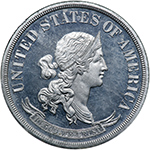 |
1869 Pattern Half Dollar. Aluminum, Plain Edge. Judd-753. Pollock-836 High Rarity 7. PCGS graded Proof 65. Tied for Finest at PCGS. Unsurpassable in terms of surface preservation, both sides are thickly frosted and essentially tone-free. The devices were struck smack on the dot at the required force by the Pattern Proof dies leaving all design elements plain and trim, clear-cut, with not even one iota of weakness as found on some examples of the various STANDARD and STANDARD SILVER types parading around in the same numerical grade.
During the late-nineteenth Century it began to occur to the Treasury Department that a subsidiary coinage -- i.e., one in which there is less than full metallic value relative to face value -- was acceptable to the public at large. The reasoning behind this was the public's ready acceptance of Civil War tokens, shin plasters (private bank notes), and Fractional Currency, none of which had any intrinsic value and yet circulated widely. Patterns such as this may have been the American government's first venture into issuing token coinage. By the 1890s, with silver's price declining fast, our fractional denominations had become true token coinage (although still minted in precious metal). It was not until 1965 when clad coins arrived that the government completed the process. (The next iteration being discussed non-publicly and site-tested is rumored to be steel alloy coins to replace the current dime, quarter, and half dollar sandwich pieces.) Pop 2; none finer at PCGS (PCGS # 60982) .
Estimated Value $5,000 - 5,500.
View details and enlarged photos
Check results on similar lots
| Unsold |
Lot 1634 |
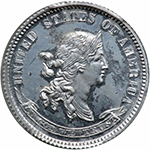 |
1870 Pattern Dime. Aluminum, Reeded Edge. Judd-847. Pollock-947 High Rarity 7. PCGS graded Proof 64. Untoned with some minor discoloration. One of the group of STANDARD silver doin proposals, the obverse bears a head of Liberty facing right, wearing a diadem, a plain ribbon encircling the hair; IN GOD WE TRUST on a scroll below. Reverse with 10 CENTS 1870 within a wreath of cotton and corn; STANDARD above. Very rare in aluminum! Pop 2; 1 finer in 65 (PCGS # 61091) .
Note: The year 1870 marks the appearance of the "Standard" reverses for the silver coins from the half dime to the dollar. Probably because of lack of time to prepare suitable obverse dies, these reverses were combined with the obverses of 1869 and a new seated Liberty design by William Barber. When this reverse design was combined with the Barber obverse design for the quarter, half and silver dollar and with the Longacre design for a silver dollar, unintentional mules resulted since United States of America does not appear on either side. The "Standard Silver" series of dimes, quarters and half dollars of 1869 were again issued dated 1870.
Estimated Value $3,500 - 3,700.
Ex: Simpson Collection.
View details and enlarged photos
Check results on similar lots
| Realized
$3,878 |
Lot 1635 |
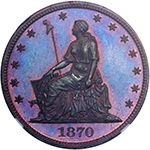 |
1870 Pattern Half Dollar. Copper, Reeded Edge. Judd-929. Pollock-1034 High Rarity 7. NGC graded Proof 64 Red & Brown Cameo PQ. CAC Approved. Wonderful red and blue colors. Pop 1; none finer at NGC .
Estimated Value $7,000 - 7,500.
View details and enlarged photos
| Realized
$7,344 |
Lot 1636 |
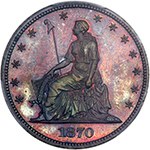 |
1870 Pattern Half Dollar. Copper, Plain Edge. Judd-930. Pollock-1035 High Rarity 7. PCGS graded Proof 64+RB. CAC Approved. Nice red and blue colors. A satiny near-Gem Proof with intense underlying mirror luster that explodes with vivid purple and blue iridescence. Absolutely eye-popping in all regards. No more, no less, just as fully struck, as attractive, as you could ask for in a STANDARD SILVER Pattern coin, with complete detail at the seated figure as well as the eagle. This handsome coin was designed by William Barber. Pop 1; 1 finer in 65 (PCGS # 71176) .
William Barber became chief engraver at the Philadelphia Mint following the death on January 1, 1869, of James B. Longacre, who had held the post since 1844. He produced many dies for pattern coins during the decade of the 1870s, most notably a large group of 20-cent pieces 1874-1875, commercial dollars and trade dollars 1873-1876, and silver dollars 1878-1879, among numerous others. His work varies from the ordinary to the inspired, perhaps his 1872 Amazonian silver coins representing his most acclaimed accomplishment in the latter category. For several years after Longacre's death, Barber used Longacre hubs and models to create new varieties of Liberty Seated motifs, later making his own version (such as this Judd-930 Pattern for a half dollar). Important to the study of patterns, William Barber was front row center during the most pivotal era of pattern issuance in American history, during the regime of Henry Linderman, during the making and/or distribution of restrikes, irrelevant mulings, etc. No doubt, if he had written a numismatic account of his time at the mint, many secrets would have been revealed. Today, the pattern field is richly endowed by his work.
Estimated Value $4,500 - 5,000.
View details and enlarged photos
Check results on similar lots
| Realized
$4,700 |
Lot 1637 |
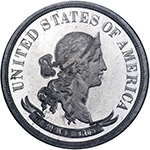 |
1870 Pattern Half Dollar. Aluminum, plain edge. Judd-956. Pollock-1100. High Rarity 7. PCGS graded Proof 64. A nice untoned pattern. The Mint from 1869 to 1871 released a wide assortment of Pattern dimes, quarters, and half dollars of the STANDARD silver type. Reverses tended to be standardized, while the attractive obverses varied in their treatment of Liberty's profile. This is one of the very rare aluminum strikes. Pop 1; 1 finer in 65. (PCGS # 61202) .
Estimated Value $2,000 - 2,100.
View details and enlarged photos
Check results on similar lots
| Unsold |
Lot 1638 |
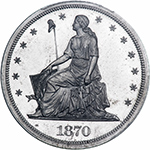 |
1870 Pattern Silver Dollar. Aluminum, Plain Edge. Judd-1007. Pollock-1140 High Rarity 7. PCGS graded Proof 65 Cameo PQ. CAC Approved. The only example graded in Proof Cameo by PCGS. Bright aluminum-silver color bursts from original surfaces unmarred by toning. A strong strike as well, making this a desirable Pattern, one of the handsomest designs in the 1870 issue that included numerous STANDARD SILVER and STANDARD designs with denominations from half dime to dollar. In light of that, we can also say this piece is extremely sharply struck with full details on both sides. William Barber's Seated Liberty design starts with Liberty's right hand supporting a shield by her side, her left hand grasping an olive branch, Liberty pole behind the right elbow. The reverse is struck from regular Seated Liberty With Motto dies for the year. Sets of these attractive Patterns were made available in silver, copper, and aluminum with either reeded or plain edges. There is no indication in the records of the price the mint charged for these. This obverse was also combined with the Standard Silver wreath reverse. Struck in aluminum with a plain edge. Exceptional quality in this highly collectible aluminum Pattern. A gleaming jewel! Pop 1; none finer at PCGS.
Estimated Value $15,000-UP.
View details and enlarged photos
| Realized
$16,450 |
Lot 1639 |
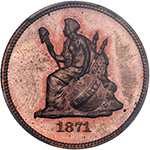 |
1871 Pattern Quarter Dollar. Copper, Reeded Edge. Judd-1094. Pollock-1230 High Rarity 7. PCGS graded Proof 64 Red & Brown PQ. CAC Approved. Lovely red toning. Longacre's seated Indian Princess motif in cameo on the obverse, sans stars, coupled with the regular Proof 1871 Seated Quarter Dollar reverse with IN GOD WE TRUST. A beautiful and very choice specimen. The pieces referred to by the catch-all title of "Patterns" are among the rarest coins ever struck in the United States Mint. There have been many attempts to define the U.S. Pattern coin family as a whole. While there are still a few exceptions, we believe that the definition included in the preface to the ninth edition of the book United States Pattern Coins: Complete Source for History Rarity, and Values by Dr. J. Hewitt Judd is the among the most comprehensive ever offered. According to this definition, "A pattern coin is one that was struck at the Philadelphia Mint (with a few exceptions) for purposes of testing a design or concept, or perhaps from unusual die pairs, or in unusual metals, or to create delicacies for collectors, but which differs from normal circulation coins of standard design, date, and metal." As a rule, patterns are exceedingly rare coins. Their original mintages are unknown, although the number of pieces extant, as well as the reasons for their striking, suggest that very few specimens were prepared. Indeed, most Pattern coins were produced to the extent of only a handful of coins. Patterns also offer considerable opportunity for continued study, as the circumstances surrounding the striking of many types and issues remain shrouded in mystery and are only slowly being revealed as more research gets published. A fascinating field in American numismatics. Tied for finest at PCGS. Pop 2; none finer at PCGS (PCGS # 71353) .
Estimated Value $8,000 - 9,000.
View details and enlarged photos
Check results on similar lots
| Unsold |
Lot 1640 |
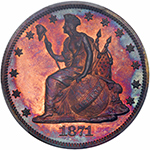 |
1871 Pattern Half Dollar. Copper, Reeded Edge. Judd-1112. Pollock-1248 Low Rarity 7. PCGS graded Proof 65 Red & Brown PQ. Lovely red and blue toning. The Longacre with stars obverse. A delightful Gem Proof featuring abundant coppery color mixed with the brown toning. On the obverse, Liberty is seated facing left with the date 1871 below. She is wearing a miniaturized Indian-style headdress and supporting a liberty pole with her right hand. Her left hand rests on a globe inscribed LIBERTY. Thirteen stars decorate the periphery. The reverse features the denomination 50 CENTS within a wreath of cotton and corn, with the inscription STANDARD above. Struck in copper with a reeded edge. The current offering is fully struck and seems fresh and attractive, with reflective fields and lovely toning. Pop 1; 1 finer in 66 (PCGS # 71371) .
1871 continues the appearance of Longacre's famous Indian Princess design on Pattern coins introduced in 1870. The motif (in modified form) subsequently appeared on later varieties through 1873. Collectors agree almost to a man that had it been adopted for circulation, the Indian Princess set would have made a beautiful addition to the nation's coinage. The design was by James Barton Longacre, Mint Engraver from 1844 until 1869. Longacre adapted Liberty's head ornamentation in modified form from his 1854 Type 2 and Type 3 gold dollars as well as the similar $3 gold pieces introduced in 1854.
Estimated Value $7,000 - 7,500.
View details and enlarged photos
Check results on similar lots
| Unsold |
Lot 1641 |
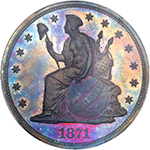 |
1871 Pattern Silver Dollar. Copper, Plain Edge. Judd-1148. Pollock-1290 Low Rarity 7. Ex Garrett 2/1980:1047. PCGS graded Proof 66 Red & Brown PQ. CAC Approved. A wonderful rainbow toned proof. Tied for finest at PCGS. One of two reported in this grade (the other appeared in a Stack's/Bowers June 2011 Baltimore sale and is mostly red without this coin's spectacular iridescent hues.) Bright mint color has mellowed at the obverse rims to a rich pleasing maroon and violet, leaving orange-red centers, while the reverse is a splendid deep violet-red. In describing this piece in 1980, Dave Bowers wrote that "the obverse is lightly toned to an orange hue. A deeper shade highlights the reverse which is predominately claret. A superb, pristine specimen which has never been cleaned and as such it is a great rarity." Indeed, the immaculate surfaces show the natural planchet striations at a microscopic level without any post-striking disturbances. A tiny planchet chip is noted above the last S in STATES on the reverse, two tiny flyspecks at the base of the flag and another at the juncture of Liberty's thigh and the globe will identify this piece. The reverse die is the regular 1871 Proof die, now in a still later state with portions of the inner circle almost worn into oblivion. No signs of double striking are noted, but the relief is very high with fully struck detail in all devices and a high wire rim around much of the coin. Examining this coin at high magnification is a delight, but viewing it from arm's length is likewise a treat. Even were it a piece without provenance it would still stand out from the rest of the known specimens only on the basis of condition, but with the superb Haseltine-Garrett pedigree, this coin becomes the landmark example of the Judd-1148 variety. Pop 2; none finer at PCGS (PCGS # 71410) .
From Bowers and Ruddy's sale of the Garrett Collection, Part II, March 1980, Lot 1047. Earlier from John Haseltine's 65th Sale, March 1883. Haseltine married the daughter of William Idler, another leading Philadelphia dealer and frequent conduit for the sale of Patterns and delicacies from the Mint to collectors of the day. Haseltine likewise became a favored distributor for Patterns in this period and he may have acquired this piece from the Mint before cataloguing his otherwise unspectacular 65th sale.
Estimated Value $25,000-UP.
View details and enlarged photos
Check results on similar lots
| Realized
$25,263 |
Lot 1642 |
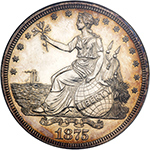 |
1875 Pattern Silver Dollar. Silver, Reeded Edge. Judd-1420. Pollock-1563 High Rarity 7. PCGS graded Proof 61 PQ. CAC Approved. Nice light golden toning around the edges. Very popular silver pattern. Lovely golden toned periphery. A Trade Dollar Pattern with Liberty at the seashore, similar to the Judd-1396 Twenty-cent Pattern, with a steam warship in the distance. The reverse is of the regular No Motto silver dollar design. Struck in silver with a reeded edge. The USpatterns.com website states that Adams and Woodin related that six pieces were struck of this pattern, and "at least 5 different pieces are confirmed." The updated pedigrees of the five known pieces are:
1. H.P. Newlin (Haseltine, April 1883); Garrett Collection, Stack's (3/76), lot 655; Harry Bass Research Foundation, currently on display at the ANA in Colorado Springs.
2. Eliasberg I (Bowers and Merena, 5/96), lot 283.
3. Getty Collection (Bowers and Ruddy, 5/77), lot 660; Randolph Rothschild Collection (Stack's, 10/03), lot 1105.
4. The present example. Heritage 4/2006:1855; ex: 1984 ANA (Kurt Krueger, 7/84), lot 660; possibly Ex: Farouk.
5. Illustrated History (Abe Kosoff, 1962), lot 476. The Judd plate coin for editions 1-7.
Only one other piece has been certified, a PR65 by PCGS. It is interesting to note the major collections from the past that lacked this pattern: Fred Olsen (1944), Gaston DiBello (1970), Armand Champa (1972), and Thomas A. Bergin (1984). Lightly but extensively hairlined, the fields are nevertheless deeply reflective and suggest a finer grade. The centers are brilliant with light golden toning around the margins. Close examination shows occasional patches of die rust on the reverse. This die rust indicates that the reverse of this particular pattern was struck from a leftover reverse die from 1865 or before. This and the similar Judd-1470 of 1876 were probably struck for sale to collectors as opposed to being true patterns. Nevertheless, a rare opportunity for the advanced collector Pop 1; 1 finer in 64 (PCGS # 61727) .
Estimated Value $17,000 - 19,000.
View details and enlarged photos
Check results on similar lots
| Realized
$22,913 |
Lot 1643 |
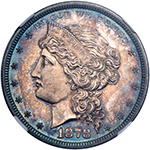 |
1878 Pattern Dollar. Silver, Reeded Edge. Judd-1554. Pollock-1733 Rarity 5. NGC graded Proof 65. Lovely blue and golden toning. Pop 3; 1 finer in 66.
Estimated Value $8,000 - 8,500.
View details and enlarged photos
| Unsold |
Lot 1644 |
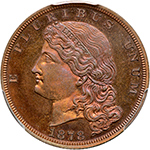 |
1878 Pattern Half Eagle. Copper, Reeded Edge. Judd-1574. Pollock-1766 High Rarity 6. PCGS graded Proof 66 Red & Brown PQ. CAC Approved. Lovely shades of red. This is another of William Barber's masterful designs. It depicts a head of Liberty sporting a band inscribed LIBERTY incused with E PLURIBUS UNUM around the margin. This portrait is similar to the one used on the famous $4 Flowing Hair Stella Patterns. The reverse employs a standing eagle with raised wings. Struck in copper with a reeded edge. The beautifully preserved fields and devices are appropriated spot-free, and display deep mirror sheen, with vibrant copper-red to golden patina in the more protected areas of each side with hints of light purple. A highly desirable Gem Proof of this stunning looking Pattern Half Eagle. Pop 2; none finer at PCGS (PCGS # 71937) .
Estimated Value $15,000-UP.
View details and enlarged photos
Check results on similar lots
| Realized
$19,975 |
Lot 1645 |
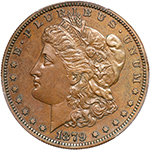 |
1879 Pattern Dollar. Copper, Reeded Edge. Judd-1616. Pollock-1812 High Rarity 6. PCGS graded Proof 64 Brown PQ. CAC Approved. Nice even brown toning. From the regular issue obverse die for the 1879 Morgan Dollar, paired to a reverse that features an eagle with lowered and spread wings. The eagle holds a large olive branch and a trio of large arrows in its talons. A needle-sharp near-Gem with sleek surfaces and color, sharp relief. Free from carbon, tarnish or marks. PCGS has only graded a few mainly lesser quality examples of this desirable Pattern in all grades. Pop 1; none finer at PCGS (PCGS # 61994) .
Estimated Value $9,000 - 9,500.
View details and enlarged photos
Check results on similar lots
| Unsold |
Lot 1646 |
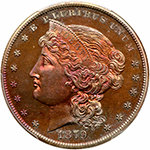 |
1879 Pattern Metric Dollar. Copper, Reeded Edge. Judd-1619. Pollock-1814 Low Rarity 7. PCGS graded Proof 65+ Red and Brown. Beautiful red mint colors and a spectacular Gem Proof. Designed by William Barber, the obverse depicts a head of Liberty wearing a coronet with pearl border inscribed LIBERTY in raised letters; E PLURIBUS UNUM above. The reverse displays a partial wreath of cotton and corn tied at the base with a ribbon and joined at the top by a tablet inscribed DEO EST GLORIA ("To God is the Glory"); within this is a circle of dots enclosing 895.8 S. 4.2�G. 100�C. 25 GRAMS. Which refers to an early attempt at coordinating the European metric system with our own unit of measure in a standard coin. Nothing came of the proposal, although a fair number of attractive Pattern Dollars like this one were struck in 1879 and 1880 before the proposal was tabled. Pop 1; 2 finer in 66 (PCGS # 71997) .
Estimated Value $7,000 - 7,500.
View details and enlarged photos
Check results on similar lots
| Unsold |
Lot 1647 |
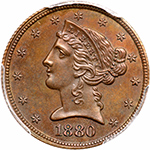 |
1880 Pattern Half Eagle. Copper, Reeded Edge. Judd-1663. Pollock-1863 Rarity 8. PCGS graded Proof 65 Brown PQ. CAC Approved. Mostly brown with slight traces of mint red here and there. The regular issue design for the With Motto Liberty half eagle. Struck in copper with a reeded edge. This example is sharply struck with mirrored fields and outstanding reflective devices. Both sides naturally toned color with few hairlines, the result of careful storage early on and continuing to the present. Only a few examples known. A gem. Pop 1; none finer at PCGS (PCGS # 62048) .
Estimated Value $20,000-UP.
View details and enlarged photos
Check results on similar lots
| Realized
$24,675 |
|
|